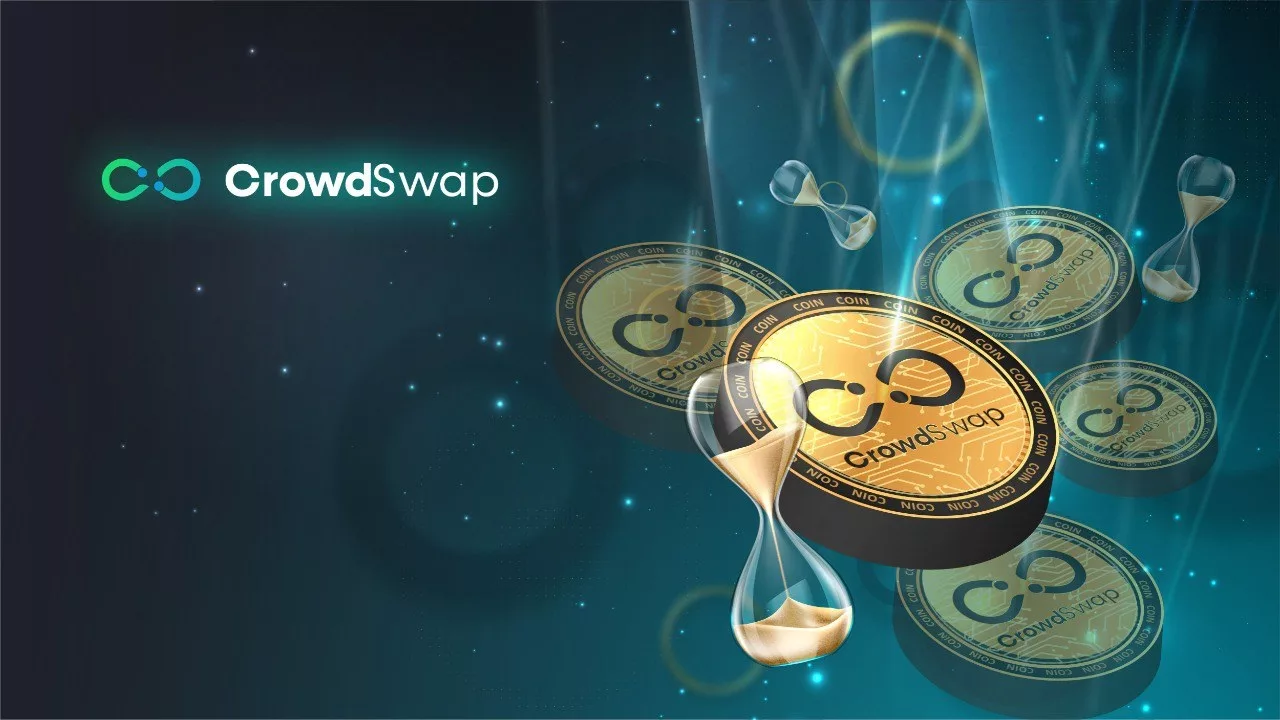Who wins?
The investors who hold or have held CROWD the longest and most consistently are to be determined. The following factors will be taken into account:
- Only CROWD that are still in the wallets at the time of the evaluation are included in the evaluation. Sales are not included in the evaluation.
- Periods of continuous ownership up to the evaluation period of CROWD. Long possession is better than short.
- Time of purchase: Early investments that are still in the wallet today are scored higher than later ones.
- The volume of continuous ownership is taken into account. More continuous ownership is better than less.
Conditions of participation
Participation is allowed for anyone
- who has at least 10,000 CROWD on his connected wallet(s) at the time of the evaluation. The definition of connected wallets can be found below.
- who is not or was not an Advisor at CrowdSwap
- whose last transaction in the wallet network was not a SELL (only BUY and SELL are considered)
- who is not an employee of the CrowdSwap project
Definitions
- The following transactions are considered to be CROWD “held”:
- CROWD in the Wallet
- CROWD in Staking
- CROWD transfers to other wallets
- CROWD Liqui-Mining
- The following transactions are not considered CROWD “held”:
- CROWD swap into other non-CROWD tokens
- Two wallets are considered “connected” if a transaction into CROWD has taken place between them. The assumption is that when CROWD is transferred from one wallet to another, both are owned by the same investor. We then speak of a “wallet network”. This can consist of 1 to n wallets.
Example: We consider the wallets A, B and C
- On Wallet A 1,000 CROWD are acquired.
- From wallet A 500 CROWD are transferred to wallet B. Thus, wallets A and B are connected. A and B now form a wallet network.
- 2,000 CROWD are now purchased on Wallet C.
- 500 CROWD are transferred from Wallet C to Wallet A. Wallet A and C are now connected. Since Wallet A was already in a wallet network with B, C is now added to this account group (since A and C are connected). The new account network is now A, B and C and so on.
Calculating the winning points
Step 1: Determination of the sweepstake period and evaluation time
The sweepstake period is from 21 February 2022 to 21 February 2023.
The sweepstakes period will be divided into 2 “winning periods”.
- “CROWD Padawans”: from 21 December 2022 up to and including 21 February 2023
- “CROWD Knights”: from 21 February 2022 up to and including 20. December 2022
Details about the winning periods:

Step 2: Determination of the eligible wallet networks
- First, ALL wallets are determined that have CROWD in the wallet, stake or liqui mining at the time of evaluation.
- It is determined between which of these wallets CROWD was transferred directly. Wallets between which a transaction was carried out are combined to form a wallet group.
- Wallet groups that contain wallets of an advisor or CROWD project employee are not taken into account.
- The last buy and sell transactions in the wallet network are determined. In case the transaction last executed is a SELL, the wallet network is not being taken into consideration for the competition.
- If this is a sale, the wallet network is no longer taken into account.
- The sum of all CROWD in a wallet network is determined (CROWD in the wallets, in the stake or in the liquidation). If this sum is < 10,000 CROWD, the wallet network is no longer taken into account.
All remaining wallet networks take part in the lottery.

Step 3: Calculation of the wallet balances in the wallet network
For each wallet network, the CROWD volumes of all contained wallets of each day in the lottery period are added up to the time of 0:00 GMT.
Example (for the period 03.03.2022 to 05.03.2022)
| date | wallet A | wallet B | wallet C | total |
| 3 March 2022 0:00 | 100 | 200 | 300 | 600 |
| 4 March 2022 0:00 | 100 | 300 | 200 | 600 |
| 5 March 2022 0:00 | 0 | 400 | 100 | 500 |
From these the winning points are calculated, as follows.
Definition: “CROWD Profit Token Package (ProToPack)”.
A “CROWD ProToPack“ is a set of tokens that has been held for a constant period of time and remained in the wallet until the evaluation time. Here it is not important whether it is the identical tokens, but only the identical quantity. Sold tokens can therefore not come into the evaluation. A ProToPack consists of the following four details:
- Quantity of CROWD tokens, called VCROWD
- Amount of time VCROWD held, called TALL
- Part of TALL spent in the period “Padawan”, called TPADAWAN
- Part of TALL spent in the period “Knight” , called TKNIGHT
ProToPack = [VCROWD, TPADAWAN, TKNIGHT], where TALL= TPADAWAN + TKNIGHT
Example for the determination of the token CROWD ProToPack
The following example will explain the properties of a ProToPack in more detail. Let’s look at a wallet network over the evaluation time and the associated balances (across the whole wallet network) for CROWD tokens held. The timeline only depicts moments with changes to the amount of CROWD tokens held.

Here, we iteratively search for the packets that were held continuously and maximally. This implies the following:
Once the wallet group had holdings of 0, all held CROWD before balance 0 are no longer considered. All held tokens before the last state 0 are irrelevant for the evaluation as those were not in the wallet network consistently.

Thus, we take all tokens left of balance 0 including the zero stands out of valuation. Let us consider the remaining period 28 July 2022 up to and including 21 February 2023.
The package with the longest time in the wallet can have the volume that is currently held in the wallet at most.
- The package with the longest time in the wallet can only have the volume of the minimum balance in the remaining time periods.
Thus, the first packet is the ProToPack No.1 shown below. Its values are:
VCROWD = 4000
TPADAWAN = 62 days (from 21.12.2022 until 21.02.2023)
TKNIGHT = 146 days (from 28.07.2022 until 20.12.2022)
TALL = 208 days

All tokens from 28 July 2022 have been taken into account, as the total of 4,000 tokens has been in the wallet network consistently. We continue analogously on the timeline creating further ProToPacks according to the following buy orders. All tokens which have already been used for the competition, will not be taken into consideration in following ProToPacks.
In our example, the next ProToPack II would have the following details:
VCROWD = 5,000 (total of 9,000 minus the 4,000 already used in ProToPack I)
TPADAWAN = 62 days (from 21 December 2022 up to and including 21 February 2023)
TKNIGHT = 82 days (from 30 September 2022 up to and including 20 December 2022)
TALL = 144 days

The tokens which were transferred to the wallet network on 24 December 2022 cannot be associated with a ProToPack, as they had not been in the wallet network until evaluation took place (they were sold on 2 February 2023).
The last ProToPack III would consist of the tokens of 21 February 2023 with the following details:
VCROWD = 4,000 (13,000 minus 9,000 already used in ProToPack I and II)
TPADAWAN = 0 day (from 21 February 2023 up to and including 21 February 2023)
TKNIGHT = 0 days
TALL = 0 day
Step 3: Determination of the winning points
- The ProToPack points of each wallet are determined.
- The evaluation function described below is applied to all ProToPacks and results in the winning points.
- The sum of all winning points of a wallet group is used for the evaluation in the lottery.
The valuation function
Assuming that a ProToPack := [VCROWD, TPADAWAN, TKNIGHT] and TALL:= TPADAWAN+ TKNIGHT, where T is calculated in days.
Calculation of the “base profit points”:
Since both the volume and the holding period are considered according to the profit conditions, the base winning points are calculated by multiplying the volume by the holding period in the respective profit zones. The following applies to the profit zones
Padawan: Holding periods in “Padawan” do not result in profit points. Short-term purchases are thus not included in the valuation.
Base profit points_Padawan = 0 (const.)
Knight: In this range volumes are multiplied by holding time
Base profit points_Knight = VCROWD * TKNIGHT
Calculation of “bonus profit points”:
In addition to the base profit points, bonus profit points are distributed based on a bonus function. The bonus function has the task of rewarding early investors who remained loyal to CROWD over those who joined later.
The bonus function multiplies the base profit points again by a factor, which is measured by how large TALL is.
The larger TALL, the larger the bonus.
Calculation of the total “winning points”:
With this the calculation of the total profit points is done
Winning points = (Base winning points_Knight) * Bonus factor(TALL)
The bonus function
As a bonus function is based on the Fibonacci sequence, starting with the Fibonacci number F2.
| F0 | F1 | F2 | F3 | F4 | F5 | F6 | F7 | F8 | F9 | F10 | F11 | F12 | F13 | F14 | F15 | F16 | |
| days after 21 Feb ’22 | 0 | 1 | 1 | 2 | 3 | 5 | 8 | 13 | 21 | 34 | 55 | 89 | 144 | 233 | 377 | 610 | 987 |
| winning factor | 1.0 | 0.95 | 0.9 | 0.85 | 0.8 | 0.75 | 0.7 | 0.65 | 0.6 | 0.55 | 0.5 | 0.45 | 0.4 | 0.35 | 0.3 |
The profit factor is now calculated as follows:
Calculate the number of days in the lottery period minus TALL. The win factor can then be read in the table above. The next smaller Fibonacci number always applies to the result.
Example: There are 365 days in the lottery period, TALL = 200. This results in 365-200 = 165. The next smaller Fibonacci number is F12 (144). Thus the factor is 0.5.













